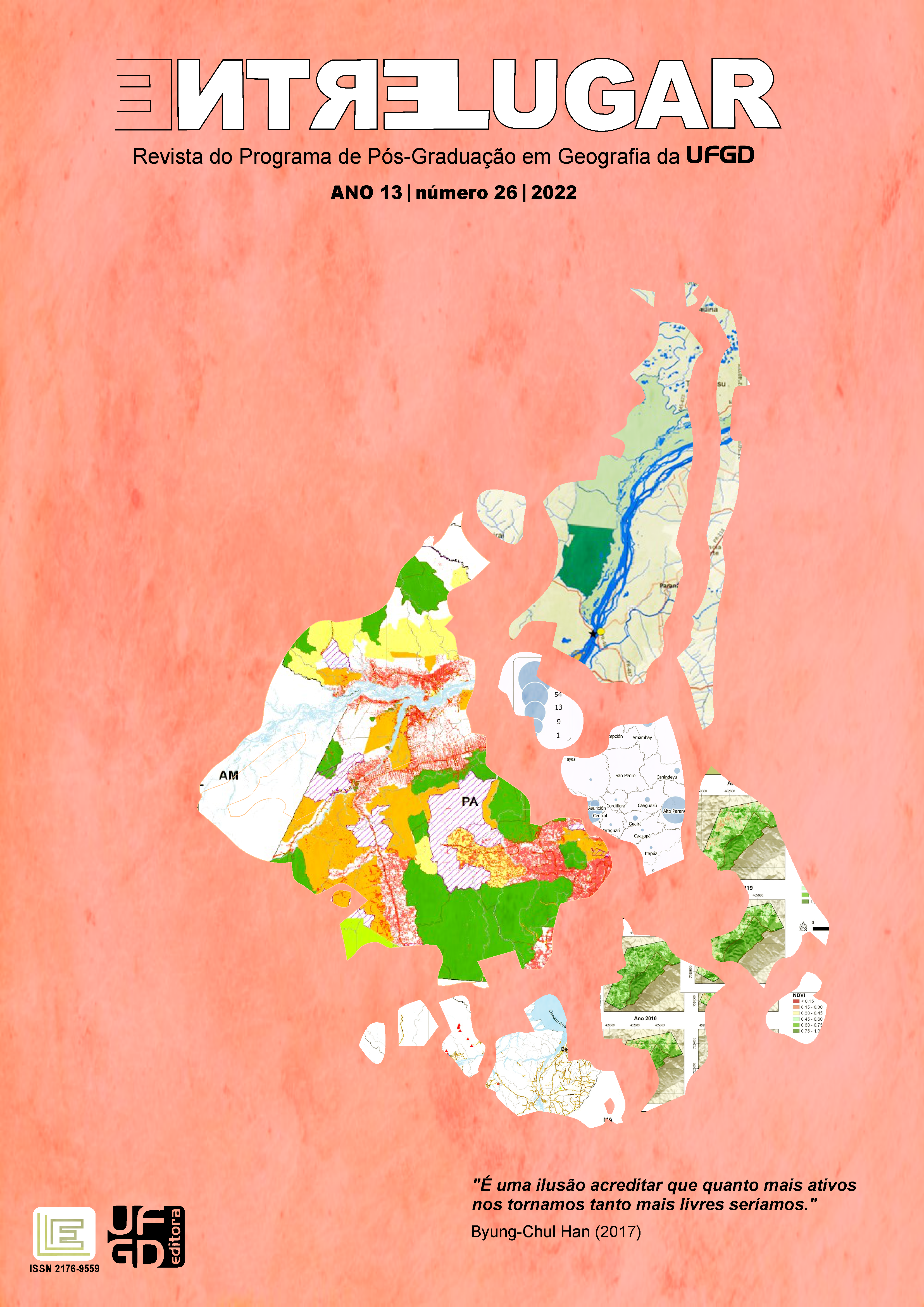Appropriation and use of natural resources in the Pará Amazon
DOI:
https://doi.org/10.30612/rel.v13i26.16234Keywords:
Appropriation. Natural Resources. Borders. Pará. Amazon.Abstract
The Pará state represents an important political jurisdiction when it comes to the Amazon Region conservation, once it encompasses the fringes of expansion to agricultural, mineral, energy and forestry activities in the Brazilian Amazon. Therefore, the state is considered a border of deforestation extension, continuously presenting the highest rates of forest loss of the region. In this study, the border limits of the Pará state were assumed to be the physical ones, despite of the conflict between state, capital and environment frontiers. In this context, the aim of this study is to present the discussion about the use and appropriation of natural resources in the so called ‘deforestation border’ of the Para state, underpinned by the bibliographic research and Bertha Becker's conceptual approach to the human occupation in the Brazilian Amazon Region. The data used to carry out this analysis includes maps and graphs that show this process in details. The results revealed that the historical occupation dynamics found in the region is subject to the policies of the National Government, which are directly intertwined with the world market. It was also possible to verify that the main actors linked to the primary and secondary forest removal were the loggers, miners and the agribusiness sector. Thus, a special attention is needed to the Amazon Region deforestation border, to allow for the development of an adequate and articulated policy that can effectively address the conservation of its natural heritage, together with the social development of its local populations.
Downloads
References
BECKER, B. K. et al. Fronteira Amazônica: questões sobre a gestão do território. Brasília: UNB/UFRJ, 1990.
BECKER, B. K. . Síntese do processo de ocupação da Amazônia: lições do passado e desafio do presente. In: BRASIL. Ministério do Meio Ambiente (Org.). Causas e dinâmica do desmatamento na Amazônia. Brasília. MMA, p. 05-28, 2001.
BECKER, B. K. . Geopolítica da Amazônia. Estudos Avançados, São Paulo, v. 19, n.53, p. 71-86, 2005.
CARVALHO, A. C., CANTO, O. Fronteira, instituições e desmatamento na Amazônia paraense: uma perspectiva de debate através do novo institucionalismo econômico. In: CANTO, O.; CONDURÚ, M. T.; SOBRINHO, M. V. (Orgs.). Gestão ambiental na Amazônia: território, desenvolvimento e contradições. Belém: NUMA/UFPA, 2017.
CONCEIÇÃO, M. F. C. Reprodução social da agricultura familiar: um novo desafio para a sociedade agrária do Nordeste Paraense. In: HÉBETTE, J.; MAGALHÃES, S. B. & MANESCHY, M. C. (Org.). No mar, nos rios e na fronteira: faces do campesinato no Pará. Ed. da UFPA, p.133-171, 2002.
CUTRIM CARVALHO, A. Frontiers and Economic Institutions in Brazil: an approach focused on the new institutional economics. Revista Brasileira de Estudos Urbanos e Regionais, v.19, n.1, p.125, mar, 2017. Disponível em: http://rbeur.anpur.org.br/rbeur/article/view/5225. Acesso em: 31 ago 2022. doi:http://dx.doi.org/10.22296/2317-1529.2017v19n1p125.
EMBRAPA. Empresa Brasileira de Pesquisa Agropecuária. 2019. Especialistas e produtores debatem sobre a expansão da soja no Pará. Disponível em: https://www.embrapa.br/busca-de-noticias/-/noticia/46487476/especialistas-e-produtores-debatem-sobre-a-expansao-da-soja-no-para.
FAPESPA. FUNDAÇÃO AMAZÔNIA DE AMPARO A ESTUDOS E PESQUISAS. Anuário Estatístico do Pará 2021. Disponível em: http://www.fapespa.pa.gov.br/anuario_estatistico/index.html. Acesso em: 08 ago. 2022.
IBGE. INSTITUTO BRASILEIRO DE GEOGRAFIA E ESTATÍSTICA. Divisão do Brasil em Mesorregiões Geográficas 2. Tomo 1-Região Norte. 1991.
IBGE. INSTITUTO BRASILEIRO DE GEOGRAFIA E ESTATÍSTICA . Censo Brasileiro de 2010. Rio de Janeiro: IBGE, 2010.
IBGE. INSTITUTO BRASILEIRO DE GEOGRAFIA E ESTATÍSTICA. Malha Municipal Digital. 2020. Disponível em: ftp://geoftp.ibge.gov.br/organizacao_do_territorio/malhas_territoriais/malhas_municipais/municipio. Acesso 01 de ago. de 2022.
IBGE. INSTITUTO BRASILEIRO DE GEOGRAFIA E ESTATÍSTICA. Produção Agrícola Municipal 2020. Rio de Janeiro: IBGE, 2021. Disponível em: https://cidades.ibge.gov.br/brasil/pa/pesquisa/14/10366?tipo=grafico&indicador=10370
INPE. INSTITUTO NACIONAL DE PESQUISAS ESPACIAIS. Programa de Monitoramento do Desmatamento da Floresta Amazônica Brasileira por Satélite - PRODES. São José dos Campos, 2020. Disponível em: http://www.dpi.inpe.br/prodes digital/prodes.php. Acesso em: 29 ago. 2022.
INPE. Instituto Nacional de Pesquisas Espaciais. Metodologia Utilizada nos Projetos PRODES e DETER. São José dos Campos, 2019. Disponível em: http://www.obt.inpe.br/OBT/assuntos/programas/amazonia/prodes/pdfs/Metodologia_Prodes_Deter_revisada.pdf
LEANDRO, L. M. L.; SILVA, F. C. da. A estrada de ferro de Bragança e a colonização da zona bragantina no estado do Pará. Novos Cadernos NAEA. v. 15, n. 2, p. 143-174, 2012.
(PNUD) PROGRAMA DE DESENVOLVIMENTO DAS NAÇÕES UNIDAS. Human development report. 2019. Disponível em: https://hdr.undp.org/sites/default/files/hdr2019.pdf Acesso em: 30 mar. 2022.
VENTURI, L. A. B. Recurso natural: a construção de um conceito. Espaço e Tempo, nº 20, p. 09 – 17, 2006.
Downloads
Published
How to Cite
Issue
Section
License
Autores que publicam nesta revista concordam com os seguintes termos:
- Autores mantém os direitos autorais e concedem à revista o direito de primeira publicação, com o trabalho simultaneamente licenciado sob a Creative Commons Atribuição-NãoComercial-CompartilhaIgual 3.0 Brasil que permitindo o compartilhamento do trabalho com reconhecimento da autoria do trabalho e publicação inicial nesta revista.
- Autores têm autorização para assumir contratos adicionais separadamente, para distribuição não-exclusiva da versão do trabalho publicada nesta revista (ex.: publicar em repositório institucional ou como capítulo de livro), com reconhecimento de autoria e publicação inicial nesta revista.
- Autores têm permissão e são estimulados a publicar e distribuir seu trabalho online (ex.: em repositórios institucionais ou na sua página pessoal) a qualquer ponto antes ou durante o processo editorial, já que isso pode gerar alterações produtivas, bem como aumentar o impacto e a citação do trabalho publicado (Veja O Efeito do Acesso Livre).




